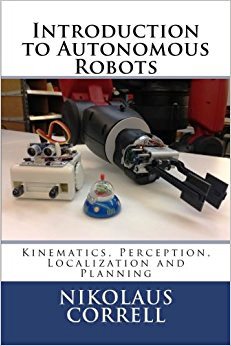| Book Name: | Introduction to Autonomous Robots |
| Category: | Artificial Intelligence |
| Free Download: | Available |
Introduction to Autonomous Robots
This book introduces the concepts of mobile and autonomous robotics to 3rd-4th grade students in computer science or related disciplines. This book covers principles of robot motion, forward and reverse kinematics of robotic arms and single-legged platforms, perception, error propagation, localization, and timing and classification. The cover image shows an intelligent inflatable toy that does not fall off the table using only a smart design and shows the importance of the process in designing an intelligent, autonomous system. This document is open source, open for contributions, and released under a Creative Commons license.

Book Description:
This book provides an algorithmic perspective on autonomous robotics for second-year students of linear algebra and probability theory. Robotics is an emerging field at the intersection of mechanical and electrical engineering with computer science. With more and more powerful computers, making robots intelligent is increasingly the focus and most difficult frontier of robotics research. Although there are a large number of textbooks on robotics and dynamics that cater to graduate students, those that provide a broad algorithmic perspective are almost exclusively limited to the graduate level. learn. Therefore, this book was developed not to create “another textbook, but better than others”, but to allow me to teach robotics to 3rd and 4th year students of the Faculty of Science. Computer Science at the University of Colorado.
Despite falling under “artificial intelligence”, standard AI techniques are not sufficient to solve problems involving uncertainty, such as the interaction of a robot in the real world. This book uses simple trigonometry to develop the kinematics equations of simple manipulators and mobile robots, and then introduces path planning, sensing, and thus uncertainty. . The problem of robot localization is introduced by formally introducing error propagation, leading to Markov localization, a particle filter, and finally an extended Kalman filter, with simultaneous localization and mapping.
Introduction to Autonomous Robots. Kinematics, Perception, Localization and Planning
Author(s): Nikolaus Correll
Publisher: Magellan Scientific, Year: 2016
Related More Books
Search Results For Keywords Introduction to Autonomous Robots
introduction to autonomous robots pdf
introduction to autonomous robots integration and programming
introduction to autonomous mobile robots
introduction to autonomous mobile robots pdf
introduction to autonomous mobile robots 2nd edition pdf
introduction to autonomous mobile robots solution manual
introduction to autonomous mobile robots github
introduction to autonomous mobile robots 2011 pdf









![[PDF] Draw Buildings and Cities in 15 Minutes Draw Buildings and Cities in 15 Minutes pdf](https://www.freepdfbook.com/wp-content/uploads/2021/06/Draw-Buildings-and-Cities-in-15-Minutes-218x150.jpg)








![[PDF] Digital Image Processing An Algorithmic Introduction Using Java Digital Image Processing An Algorithmic Introduction Using Java](https://www.freepdfbook.com/wp-content/uploads/2022/06/Digital-Image-Processing-An-Algorithmic-Introduction-Using-Java.jpg)




![[PDF] 43 Years JEE ADVANCED + JEE MAIN Chapterwise & Topicwise Solved Papers 43 Years JEE ADVANCED (1978-2020) + JEE MAIN Chapterwise & Topicwise Solved Papers Physics PDF](https://www.freepdfbook.com/wp-content/uploads/2022/03/43-Years-JEE-ADVANCED-1978-2020.jpg)

![[PDF] Problems in Physical Chemistry for JEE (Main & Advanced) Problems in Physical Chemistry for JEE (Main & Advanced) Free PDF Book Download](https://www.freepdfbook.com/wp-content/uploads/2022/03/Problems-in-Physical-Chemistry-for-JEE-Main-Advanced.jpg)
![[PDF] Engineering Physics (McGraw Hill)](https://www.freepdfbook.com/wp-content/uploads/2021/05/bafc8c2685bb6823a9c56134f7fba5df.jpeg)

![[PDF] Engineering Chemistry By Shashi Chawla](https://www.freepdfbook.com/wp-content/uploads/2022/05/Theory-And-Practicals-of-Engineering-Chemistry-By-Shashi-Chawla-free-pdf-book.jpeg)
![[PDF] Chemistry: An Introduction to Organic, Inorganic & Physical Chemistry Chemistry: An Introduction to Organic, Inorganic & Physical Chemistry](https://www.freepdfbook.com/wp-content/uploads/2022/04/Chemistry-An-Introduction-to-Organic-Inorganic-Physical-Chemistry.jpg)
![[PDF] Essentials of Physical Chemistry Essentials of Physical Chemistry Free PDF Book by Bahl](https://www.freepdfbook.com/wp-content/uploads/2022/04/Essentials-of-Physical-Chemistry-bahl.jpg)
![[PDF] Biological control of plant-parasitic nematodes: soil ecosystem management in sustainable agriculture Biological control of plant-parasitic nematodes: soil ecosystem management in sustainable agriculture](https://www.freepdfbook.com/wp-content/uploads/2022/05/Biological-control-of-plant-parasitic-nematodes-soil-ecosystem-management-in-sustainable-agriculture.jpg)
![[PDF] Human Anatomy: Color Atlas and Textbook Human Anatomy: Color Atlas and Textbook Free PDF Book](https://www.freepdfbook.com/wp-content/uploads/2022/05/Human-Anatomy-Color-Atlas-and-Textbook.jpg)
![[PDF] Concepts of Biology Book [Free Download]](https://www.freepdfbook.com/wp-content/uploads/2022/05/Concepts-of-Biology.jpg)
![[PDF] Essentials of Biology [Free Download] Essentials of Biology Free PDF BOok Download](https://www.freepdfbook.com/wp-content/uploads/2022/05/Essentials-of-Biology-Free-PDF-Book-Downlaod.jpg)
![[PDF] Human Biology Book [Free Download]](https://www.freepdfbook.com/wp-content/uploads/2022/05/PDF-Human-Biology-Book-Free-Download.jpg)


